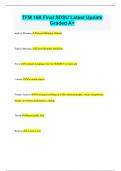Real Estate Finance & Investments,
2024 Release by
William B. Brueggeman
Complete Chapter Solutions Manual
are included (Ch 1 to 23)
** Immediate Download
** Swift Response
** All Chapters included
** Excel Spreadsheets
,Table of Contents
1 Real Estate Investment Basic Legal Concepts
2 Real Estate Financing Notes and Mortgages
3 Mortgage Loan Foundations The Time Value of Money
4 Fixed Interest Rate Mortgage Loans
5 Adjustable and Floating Rate Mortgage Loans
6 Mortgages Additional Concepts, Analysis, and Applications
7 Single-Family Housing Pricing, Investment, and Tax Considerations
8 Underwriting and Financing Residential Properties
9 Income-Producing Properties Leases, Rents, and the Market for Space
10 Valuation of Income Properties Appraisal and the Market for Capital
11 Investment Analysis and Taxation of Income Properties
12 Financial Leverage and Financing Alternatives
13 Risk Analysis
14 Disposition and Renovation of Income Properties
15 Financing Corporate Real Estate
16 Financing Project Development
17 Financing Land Development Projects
18 Structuring Real Estate Investments Organizational Forms and Joint Ventures
19 The Secondary Mortgage Market Pass-Through Securities
20 The Secondary Mortgage Market CMOs, CDOs, CLOs, and Derivative Securities
21 Real Estate Investment Trusts (REITs)
22 Real Estate Investment Performance and Portfolio Considerations
23 Real Estate Funds Structure, Performance, Benchmarking, Risk and Attribution Analysis
, Solutions to Questions—Chapter 23
Real Estate Investment Funds: Structure, Performance, Benchmarking, and Attribution Analysis
Question 23-1
What are the primary differences between an open-end and closed-end fund? Why would an investor
choose to invest in one or the other?
An open-end fund allows investors to invest or withdraw capital from the fund overtime. A closed end fund
is usually closed to new investment after a specified amount of capital is raised. It does not allow investors
to withdraw funds until fund objectives are achieved and is liquidated. Open end funds may be thought of
as ongoing funds that expand or contract as investors make additional investments or withdraw capital from
the fund. Closed end funds are usually more focused and may have a finite life. Open end funds are usually
well diversified whereas a closed end fund often has a focus on a particular property type or geographic
area. Closed end funds are often used for riskier investments. The fund that is best for an investor depends
on their expected returns, need for liquidity and need for diversification.
Question 23-2
What is the difference between a time-weighted return and an internal rate of return? When reporting
historical investment performance to investors in a core fund, which return would be more likely to be
reported? What return would likely be used for an opportunity fund?
Unlike the IRR, time-weighted returns (TWR) are not impacted by the amount of capital invested each
period, however, in order to calculate a TWR, an appraisal must be made each period. An IRR does not
require an appraisal but is impacted by the amount of funds invested each period. A core fund generally has
stabilized investments that can be valued each period and are usually open end. The manager has no control
over the flow of capital in or out of the fund each period. Thus, when measuring performance, the TWR is
usually considered best for core funds. Opportunity funds often include properties such as development
projects or properties that are not yet stabilized, e.g., may require repositioning, renovation and lease-up.
These investments are usually held in closed end funds and the manager has control over the amount of
capital invested. Thus, the IRR is usually considered best for opportunity funds.
Question 23-3
Which type of fund, core or opportunistic, would you expect to have higher returns? Why? Which would be
expected to have greater volatility in returns? Why?
Opportunistic funds take on riskier investments such as properties requiring significant renovation and
development projects. They also use more leverage than a core fund which invests mainly in stabilized
properties and may also be well diversified geographically and by property type. Because they are more
focused and may require a longer period of time before reaching stabilized occupancy and expected cash
flow, most opportunity funds are riskier and are expected to earn a higher return than core funds.
Question 23-4
What is meant by a target return? How does it relate to an investment benchmark?
When managers create funds and performance is to be measured and reported to investors, a “benchmark”
is usually chosen to compare how the fund is performing relative to other investment funds. For example,
an open and core fund may choose the NPI (see chapter) as both its benchmark and target return. However,
to the extent that such a fund has a strategy that differs as to property type and/or location from those
represented by the benchmark index, the manager may choose a target return which may be higher or lower
than the benchmark. For example, if a fund manager creates a core fund but adopts a strategy to overweight
the fund in a certain geographic region (e.g., the “sunbelt”), it will be less diversified than properties
represented in the index. Therefore, the manager may choose the NPI as a benchmark index but may add a
premium to it when specifying its target return. This premium compensates investors for less diversification
and perhaps greater risk when compared to the benchmark index. Similarly, if a core fund manager chooses
to overweight its investment portfolio with a certain property type (e.g., apartments) because that sector is
expected to do well, it may add a premium to the benchmark when defining its target return. So in both of





